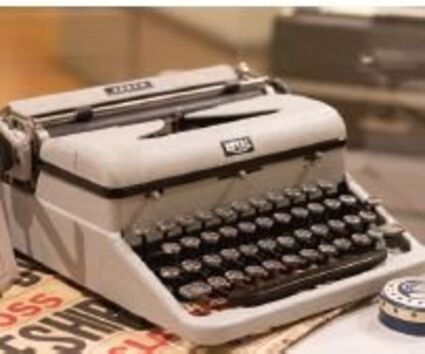Brian Young goes old school with museum typewriter exhibit
July 5, 2022

Royal Typewriter
Brian Young is helping keep history at our fingertips.
He does so with his collection of vintage typewriters – some more than a century old – which he has loaned to the Skagit County Historical Museum in La Conner for a special exhibit highlighting the office machine that, prior to the personal computer, was an essential part of most homes and businesses.
Young is guest curator of “Hunt and Peck,” a display featuring over three dozen of his amazing, well-conditioned machines, the stories behind them shared in great detail – complete with period magazine ads and newspaper front pages – in the museum’s north wing.
The exhibit opened June 16 and will run into the fall.
Young’s fascination with old typewriters began in earnest nearly a decade ago. He was browsing in a Mount Vernon antique store when he came across what collectors call a classic “alphabet piano.”

“I fell in love with it,” Young recalls. “I don’t know why. But I made an offer to buy it.”
Since then, Young has added significantly to his collection and done extensive research into the respective histories of those typewriters, some of which were made overseas.
His exhibit includes Underwoods, Royals, Smith-Coronas, Remingtons, Olivettis and Hammonds, some of the marquee names of the pre-electric typewriter industry.
There are typewriters of different sizes, colors, and shapes depending on the needs for which they were designed. Those with wider carriages were used to prepare legal documents. Schools and parents bought more standard sized models for children learning to type. One German typewriter bears a key that allowed typists to use the logo of Hitler’s SS, or Schutzstaffel, one of the most feared elements of the Third Reich.

In addition to the histories of his machines, Young is intrigued by the craftsmanship that went into their manufacture.
“The ingenuity that went into them is impressive,” he said.
One flaw plagued even the best typewriters, however. They tended to be dust collectors, which despite constant oiling, caused them to gum up.
In fact, said Young, the placement of letters on keyboards was designed to minimize the jamming of typewriter keys. That no longer is a concern with computer keyboarding, yet the QWERTY format remains in place.
“There really isn’t any reason to still have QWERTY,” Young said. “It’s funny that we still have a format that has been around since before 1900.”

Typewriter marketing likewise eventually came into play. Thus, the eventual move to additional colors and designs.
“It’s like when Henry Ford said that you can have any model as long as it’s black,” Young said. “So, Chevy started making cars with different colors. Same thing with typewriters. They started coming out in different colors and styles to appeal to different generations.”
Buying a typewriter, said Young, represented an important investment.
“In those days, when a house cost $4,000,” he pointed out, “a typewriter might cost $75. They were so valuable that each one had a serial number. They were an integral part of the office and home.”
In the museum exhibit, an Olympia typewriter is made available for visitors to keystroke onto copy paper. For those who grew up in the computer age, the keys seem heavy and hard to strike. The letters appear faded, some words beset with annoying “skips.”
Even so, typewriters are making a comeback. The retro look is in, Young said. He said actor Tom Hanks collects typewriters much as comedian Jay Leno does cars.
Interestingly, demand for Corona typewriters increased during the coronavirus pandemic. The PC may be here to stay, but typewriters still have their place.
And for the next few months, thanks to Young, that place is the Skagit County Historical Museum.

Reader Comments(0)